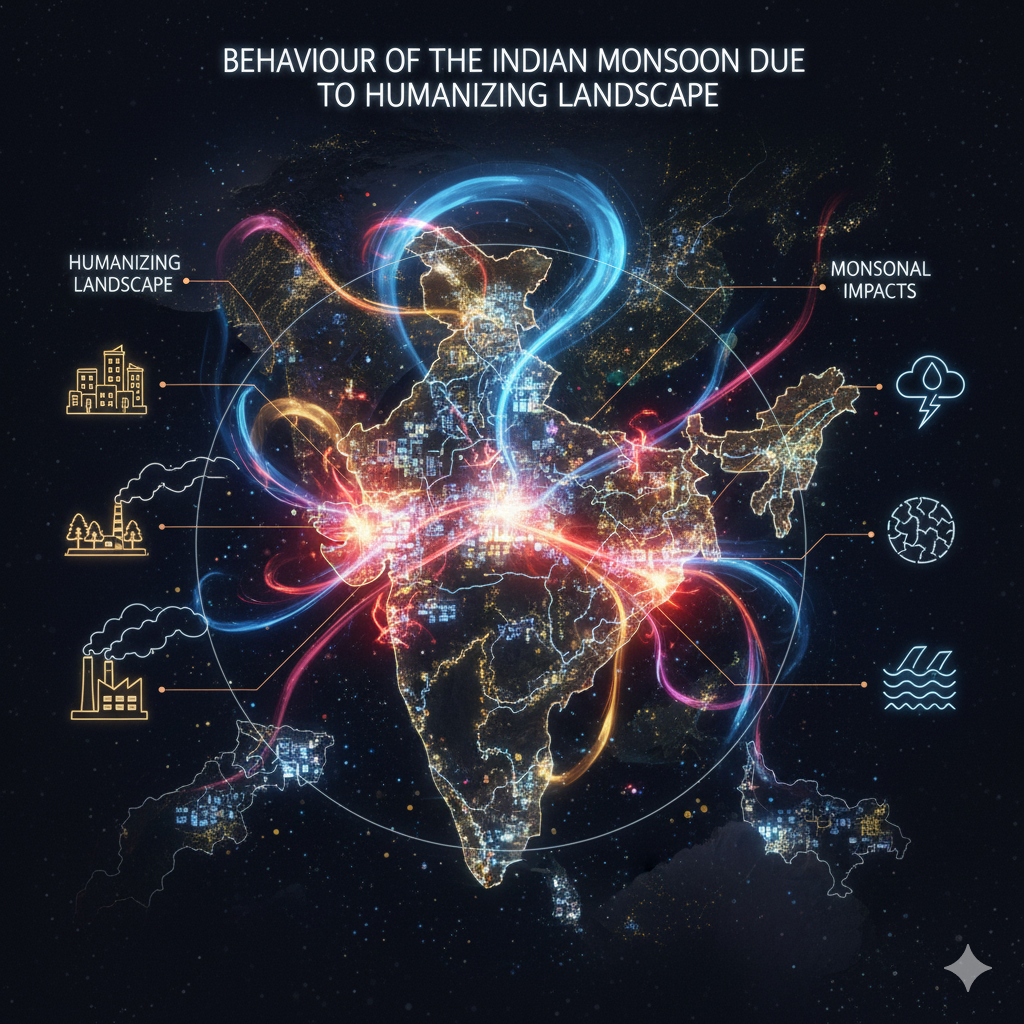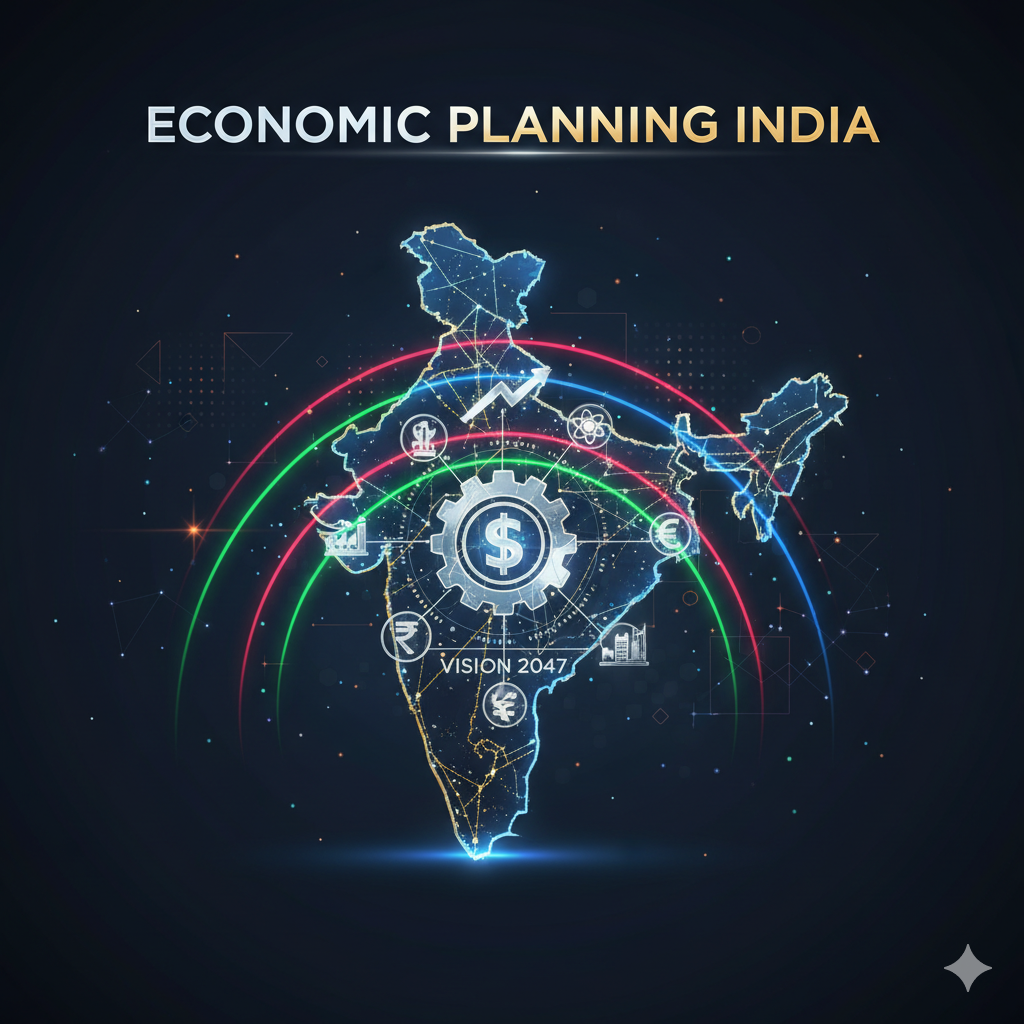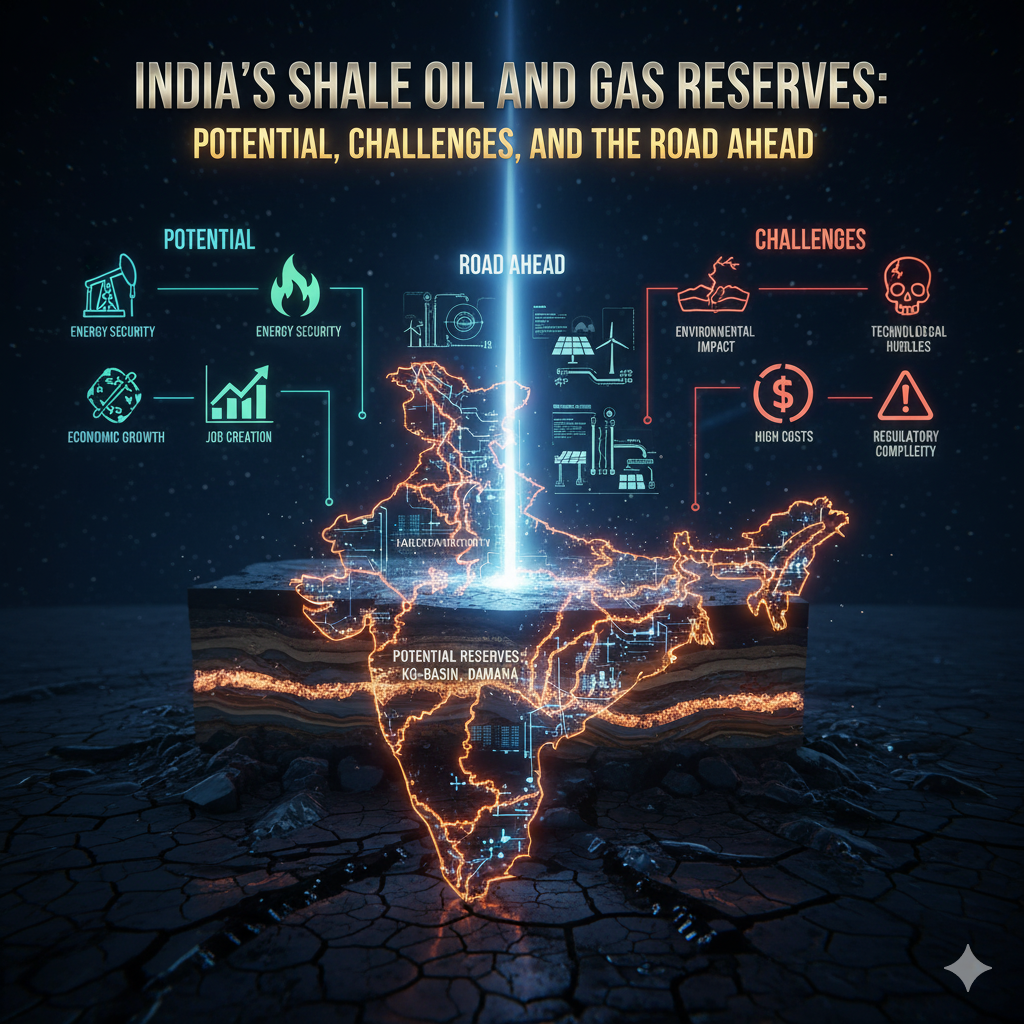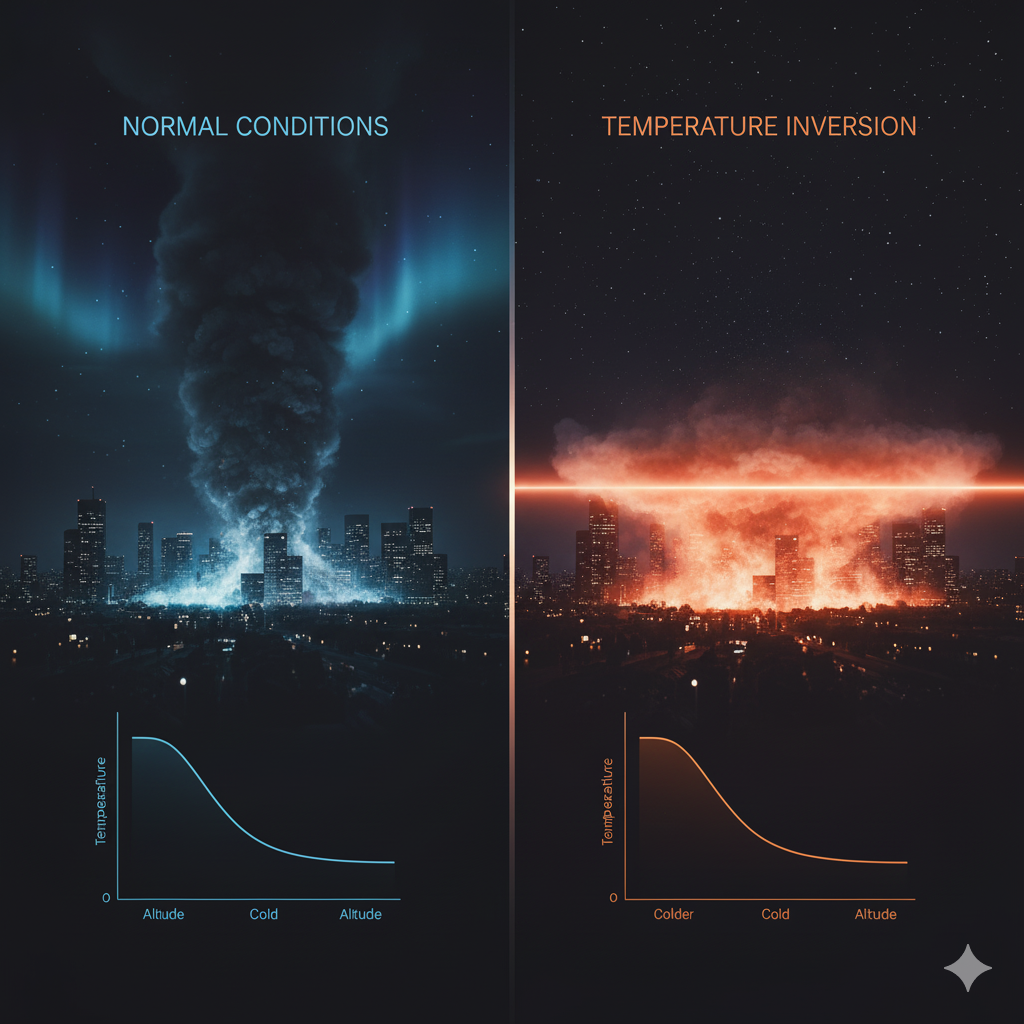Introduction
The Indian monsoon is one of the most prominent climatic phenomena on Earth. It is a seasonal reversal of winds accompanied by heavy rainfall that sustains nearly 1.4 billion people, agriculture-based economies, and diverse ecosystems in South Asia. The monsoon is not merely a meteorological event but the lifeline of India’s socio-economic system. Traditionally, the monsoon has been considered a natural process governed by large-scale atmospheric circulation, land-ocean temperature contrast, and the Inter-Tropical Convergence Zone (ITCZ).
However, over the past few decades, a growing body of evidence suggests that the behaviour of the Indian monsoon is undergoing significant changes. The reasons are not limited to natural variability but are deeply connected with human-induced landscape modifications such as deforestation, urbanization, industrialization, excessive groundwater extraction, and changes in land use patterns. These changes, often described as the “humanizing of landscapes,” have altered the thermal, hydrological, and ecological balance of the Indian subcontinent, thereby reshaping the nature of the monsoon.
This essay seeks to critically examine the factors behind the changing behaviour of the Indian monsoon due to humanizing landscapes, its consequences on agriculture, economy, and society, and possible mitigation strategies.
Understanding the Indian Monsoon
The Indian monsoon is driven by the differential heating of land and ocean, resulting in a seasonal reversal of winds.
- Southwest Monsoon (June–September): Moist winds from the Indian Ocean bring about 75% of India’s annual rainfall.
- Northeast Monsoon (October–December): Provides rainfall to Tamil Nadu and parts of Andhra Pradesh.
The timing, intensity, and spatial distribution of monsoon rainfall are crucial for agriculture, water resources, and economic stability. Even slight deviations can lead to droughts, floods, or crop failures.
Humanizing of Landscapes: Concept
“Humanizing of landscape” refers to the large-scale transformation of natural landscapes by human activities to suit developmental, economic, and social needs. This includes:
- Deforestation and loss of natural vegetation
- Urbanization and expansion of built-up areas
- Agricultural intensification and monoculture farming
- Industrial development and mining
- Excessive groundwater exploitation
- River regulation through dams and barrages
These activities alter the land–atmosphere interaction, surface albedo (reflectivity), evapotranspiration, and soil moisture — all of which are key determinants of monsoon circulation and rainfall distribution.
Evidence of Changing Behaviour of the Indian Monsoon
1. Declining Rainfall Trends
- Studies by the Indian Meteorological Department (IMD) show that average monsoon rainfall has declined in several regions, especially central India, over the last five decades.
- Frequency of moderate rainfall days has reduced, while extreme rainfall events have increased.
2. Shifts in Onset and Withdrawal Dates
- The monsoon is showing delays in onset and earlier withdrawal in some years, disturbing cropping patterns.
- Irregularity in onset dates creates uncertainty for sowing kharif crops.
3. Spatial Variability
- Traditional monsoon zones are experiencing shifts in rainfall patterns.
- Northeast India, once the rainiest part, is witnessing declining rainfall.
- Northwestern India (Rajasthan, Haryana) is experiencing increased rainfall variability.
4. Rise in Extreme Weather Events
- Human-induced landscape changes have led to more localized, intense downpours.
- Example: The Mumbai floods (2005, 2017), Kerala floods (2018), and Uttarakhand cloudbursts (2013, 2021).
Humanizing Landscape and Its Impact on Monsoon Behaviour
1. Deforestation and Land Use Change
- Large-scale deforestation in the Western Ghats, Northeast, and Central India has reduced moisture recycling and local rainfall.
- Forests contribute to rainfall by evapotranspiration; their loss decreases humidity and weakens local monsoon circulation.
- Example: Deforestation in the Western Ghats has been linked to declining rainfall in Kerala and Karnataka.
2. Urbanization and Heat Island Effect
- Rapid urbanization creates urban heat islands that alter convection and cloud formation.
- Cities like Delhi, Mumbai, and Bengaluru experience localized heavy rainfall events due to increased surface heating and pollution.
- Urban sprawl also reduces natural infiltration, increasing floods during monsoon.
3. Agricultural Intensification
- Monoculture farming, excessive irrigation, and paddy cultivation in unsuitable areas increase surface evaporation.
- Groundwater depletion in states like Punjab and Haryana affects soil moisture balance, altering regional monsoon–land interaction.
- Shifts in cropping patterns (wheat–rice cycles) increase water stress and reduce resilience to monsoon variability.
4. Industrialization and Pollution
- Aerosols and industrial emissions influence cloud microphysics and rainfall.
- Aerosol particles act as cloud condensation nuclei, sometimes suppressing rainfall or causing highly localized rainfall events.
- Increased greenhouse gases enhance global warming, modifying the monsoon circulation system.
5. Dams and River Regulation
- Dams and reservoirs alter local evaporation and soil moisture, influencing regional convection.
- Reduced sediment flow to coasts also affects monsoon–ocean interactions.
6. Groundwater Extraction
- Over-extraction of groundwater changes the sub-surface hydrology.
- Studies suggest that groundwater depletion in northwestern India has led to reduced evapotranspiration, affecting monsoon feedback mechanisms.
How Humanizing Landscape Alters Monsoon Dynamics
- Albedo Effect: Replacement of forests with croplands or urban surfaces changes Earth’s reflectivity, altering heat balance.
- Moisture Recycling: Natural vegetation recycles atmospheric moisture; deforestation reduces this mechanism.
- Surface Roughness: Forests slow down winds and aid cloud formation; barren lands reduce this effect.
- Aerosol Loading: Human-induced pollution modifies cloud droplets, leading to uneven rainfall.
- Feedback Loops: Reduced rainfall further degrades land, creating a vicious cycle of desertification and monsoon weakening.
Regional Case Studies
1. Western Ghats
Deforestation has led to reduced orographic rainfall. This has impacted coffee and spice plantations, water resources, and hydropower generation.
2. Northeast India
Once known for its heavy rainfall, this region is facing reduced monsoon rainfall due to deforestation, jhum cultivation, and urbanization.
3. Indo-Gangetic Plain
Excessive groundwater extraction and pollution have altered the land–atmosphere interaction, weakening monsoon predictability.
4. Urban India (Delhi & Mumbai)
Urban heat islands and pollution have resulted in extreme localized rainfall, often leading to urban floods.
Consequences of Changing Monsoon Behaviour
- Agriculture and Food Security
- Erratic monsoons disrupt crop cycles, leading to reduced yields.
- Droughts and floods cause farmer distress, increasing dependence on irrigation.
- Water Resources
- Irregular rainfall affects groundwater recharge and dam storage.
- States dependent on monsoon-fed rivers face acute water crises.
- Economy
- India’s GDP is still sensitive to monsoon fluctuations, especially in rural areas.
- Insurance costs and disaster relief burdens increase.
- Health and Society
- Floods spread waterborne diseases.
- Heatwaves and droughts worsen malnutrition and migration.
- Ecosystems and Biodiversity
- Wetland loss, forest dieback, and drying rivers disrupt ecosystems.
- Species dependent on seasonal rainfall face habitat stress.
Mitigation and Adaptation Strategies
1. Afforestation and Ecosystem Restoration
- Large-scale tree plantation drives in the Western Ghats, Himalayas, and central India can revive rainfall feedback cycles.
2. Sustainable Urban Planning
- Reducing heat islands through green infrastructure, rooftop gardens, and permeable surfaces.
3. Agricultural Reforms
- Shifting to less water-intensive crops, efficient irrigation (drip irrigation), and rainwater harvesting.
4. Pollution Control
- Reducing aerosol emissions through cleaner industrial practices and renewable energy adoption.
5. Water Management
- Limiting over-extraction of groundwater, promoting watershed development, and interlinking rivers in an ecologically sensitive manner.
6. Climate-Smart Governance
- Strengthening IMD forecasting systems, early warning mechanisms, and farmer advisories.
Conclusion
The Indian monsoon, once considered a gift of nature, is now deeply influenced by humanizing landscapes. Deforestation, urbanization, industrialization, agricultural intensification, and excessive exploitation of resources have collectively altered its behaviour. The result is a more erratic, uneven, and extreme monsoon system, with profound implications for agriculture, water security, economy, and society.
Thus, it is reasonable to conclude that the behaviour of the Indian monsoon is indeed changing due to human-induced landscape modifications. The challenge for India is to adopt sustainable development pathways that balance economic growth with ecological stability. Restoring natural landscapes, reducing emissions, and adopting adaptive strategies will be key to ensuring that the monsoon remains a dependable lifeline for future generations.




